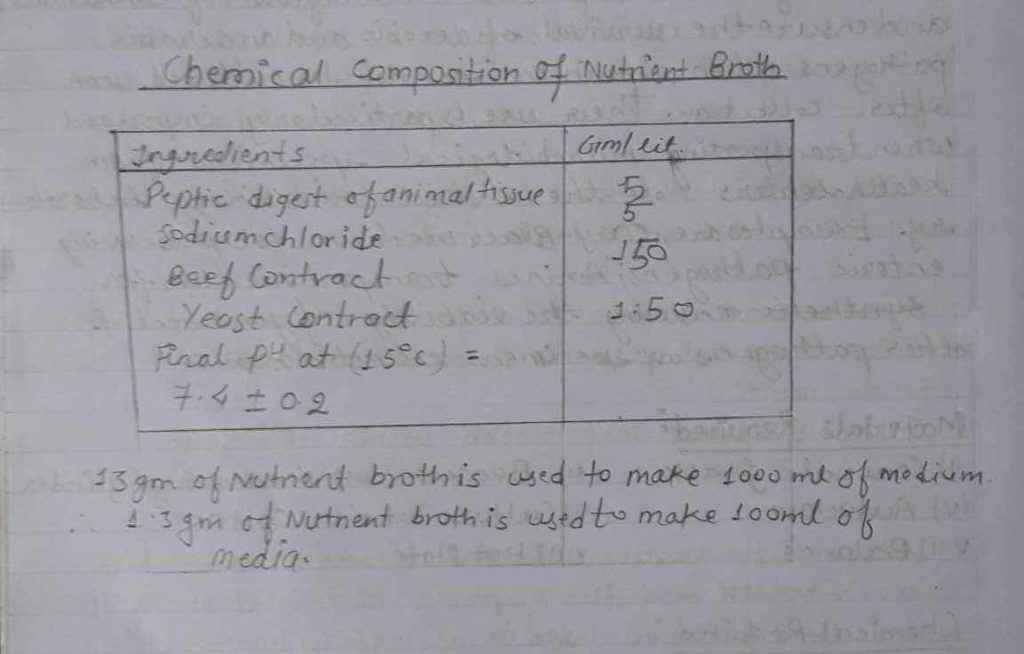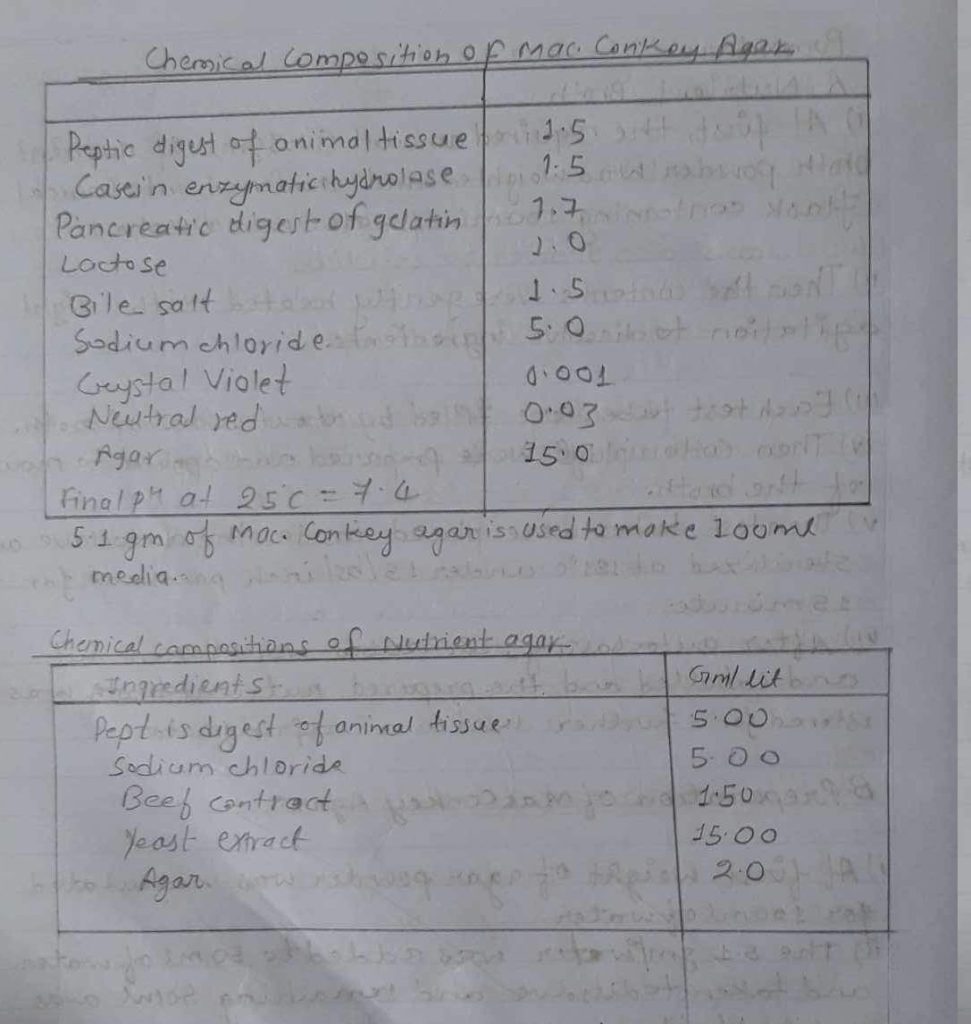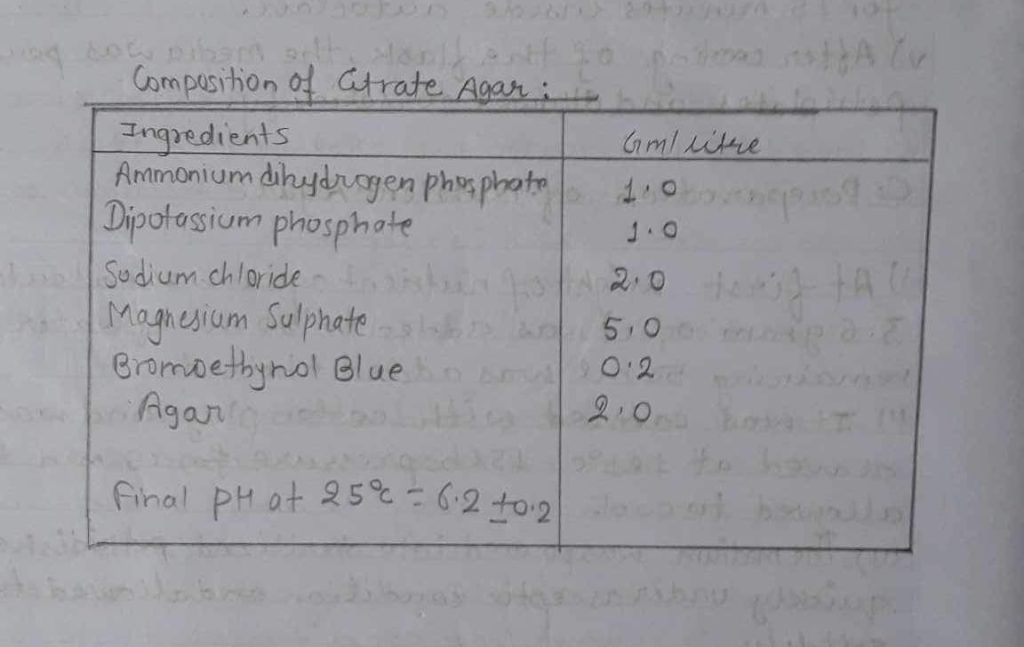Culture Media:-
Micro-organism like all other living organism required basic nutrients for their growth and development. The nutrient preparation food (food material) in which micro-organisms are grown in the laboratory is called a culture media and growth itself is called a culture.
Media have been classified variously using different criteria like chemical composition, physical state and utility purpose. On the basis of their composition there are three main types of culture media:
i) Natural or empirical Culture Media: – Those media whose exact chemical composition is not known are called natural or empirical culture media. These include milk, urine, diluted blood, vegetable juices, meat extracts and infusions, etc.
ii) Semi-Synthetic Culture media:- Those cultures whose chemical composition is partially known are called semi-synthetic media. Any medium which contains agar becomes a semi-synthetic medium- Examples are Potato Dextrose agar,czapek dox agar etc.
iii) Synthetic or a chemically defined culture media:- Those media which are composed of special substances of known chemical composition are called synthetic media. Examples are the Czapek solution, Richard’s solution.
On the basis of physical state, media are in three forms:-
i) Solid
ii) Semi-solid
iii) Fluid
i) Solid Culture media:- This form of media is used mainly in Petri dishes as plate cultures. It can also be used in bottles or tubes as tab (deep) or slope cultures. These media usually contain a concentration of 1-0-2% agar to yield a suitable gel. The solid culture media are used
to observe the colonial appearance, shape, size of Colony and the changes in the surrounding medium which help to identify the bacteria and differentiate commensa is from pathogens. Examples are Nutrient agar, Blood agar,chocolate agar etc.
ii)Semi-Solid Culture media:- This form of medium is prepared by adding a small amount of agar (0.2-0.5% w/V) to a fluid medium · Semi-solid media are used mainly as transport media and for motility testing. Examples are, Amines, transport medium, Cary-Blair transport medium etc.
iii) Fluid Culture media: -This form of media does not contain agar or any solidifying agent. Growth of mos in these media is shown by a turbidity in the medium. Fluid culture media are used mainly as enrichment media, biochemical testing media and blood culture media. Examples are Tryptone broth, selenite F broth, Nutrient broth, etc.
On the basis of utility purpose,the main types of culture media are :-
i) Basal media: These are simple media which support the growth of micro-organisms that do not have special nutritional requirements. Basal media are also known as general purpose media. These are often used in the preparation of enriched media, to maintain stock cultures to control strains of bacteria, and for subculturing pathogens from differential or selective media prior to performing biochemical and serological identification tests. Examples are Nutrient agar, Nutrient broth.
ii)Enriched Media: These are media that are enriched with whole blood, lysed blood, serum, extra peptones, special extracts, or vitamins to support the growth of pathogens that require additional nutrients or growth stimulants. Examples are Blood agar, loeffler serum medium,Tryptone Soyagar etc.
iii) Enrichment Media: These are fluid media that increase the numbers of a pathogen by containing enrichments and or substances that discourage the multiplication of unwanted bacteria. For example, selenite broth, is used as an enrichment medium for salmonella in faeces Or Urine prior to subculturing on xylose lysine deoxycholate (XCD) agar or other enteric selective medium.
iv) Selective media: These are media which contain substances that inhibit or slow down the growth of micro-organisms other than the pathogens for which the media are intended. This type of media facilitates the isolation of particular species from a mixed inoculum. In recent years, antimicrobial agents have become increasingly used as selective agents in culture media. Examples are, XLD agar for Salmonellae & Shigella, Butzler medium for campylobacter species.
v)Differential Media: These are media to which indicators, dyes or other substances are added to differentiate mos. This type of media can also be known as Indicator media as this media incorporate some substance that is changed visibly as a result of the metabolic activities of particular organisms. For example TCBS agar contains the indicator bromothymol blue which differentiates sucrose fermenting from non-sucrose fermenting vibrio sps. Mac conkey agar contains the indicator neutral red which differentiates lactose fermenting from non-lactose fermenting organisms of the enterobacteriaceae group. Blood agar can also be described as a differential medium. When it differentiates haemolytic from non-haemolytic baderia
vi)Transport Media: These are mostly semisolid media that contain ingredients to prevent the overgrowth of commensals and ensure the survival of aerobic and anaerobic pathogens when specimens cannot be cultured soon after collection. Their use is particularly important when transporting microbiological specimens from health centers to the district microbiology laboratory. Examples are, Cary-Blair medium for preserving enteric pathogens; Amines transport medium for ensuring the viability of gonococci and other pathogens in specimens collected in swabs.
Materials Required:
i) Conical flask
ii) Autoclave
iii) Balance
iv) Beaker
v) Measuring Cylinder
vi) Culture Tube
vii) Cotton
viii) Hot Plate.
Chemical Required:
i) Nutrient Broth Powder (50ml)
ii) Nutrient Agar (100ml)
iii) Macconkey agar (100ml)
iv) Simmon Cu Agar (50ml)
v) Distilled water
Procedure:
A. Nutrient Broth:
i) At first, the required amount (1.3gm) of nutrient broth powder was weighed and transferred into a conical flask containing 100 ml of water was dissolved.
ii) Then the contents were gently heated with slight agitation to dissolve ingredients.
iii) Each test tube was filled with about 10 ml of broth.
iv) Then cotton plugs were prepared and applied to the mouth of the broth.
v) Then test tubes were placed inside the autoclave and sterilized at 121°c under 15/bs/inch pressure for 15 minute
vi) After autoclaving, the tubes were taken out and labelled and the prepared nutrient broth was stored for further use in a refrigerator.

B. Preparation of macConkey Agar:
i) At first the weight of agar powder was calculated for 100 ml of water.
ii) The 5.1gm powder was added to 50ml of water and taken to dissolve and remaining 50 ml was added to it.
iii) The mixture was heated to dissolve the powder homogeneously and the conical flask was covered with a Cotton plug.
iv) Then it was sterilized at 121°c at 15 lbs pressure for 15 minutes inside the autoclave.
v) After cooling of the flask, the media was poured to petri plates and allowed to solidify.
C. Preparation of Nutrient Agar:
i) At first weight of nutrient agar was calculated and 3.6 grams of it was added to 50 ml of water and remaining 50 ml was added & boiled.
ii) It was covered with cotton plug and was autoclaved at 121°C 15 lbs pressure for 15 min and was allowed to cool.
iii) The medium was poured into sterilized petri dishes quickly under aseptic conditions and allowed to cool to solidify.

D. Preparation of Citrate Agar:
i) At first 5.1 gm of citrate agar was weighed and poured into a conical flask.
ii) 100 ml of water was added to it and shaken well followed by heat.
iii) Then it was allowed to cool and was poured into the test tubes. It was allowed to cool in a slanted position, and was kept in the refrigerator.

Result :
Thus the different culture media such as Nutrient agar, nutrient broth, Mac Cankey Agar and citrate Agar were prepared using various steps in Sterilised Condition.
Precautions:
i) Too hot media should not be poured in Petriplaes since it produces much condensed water in the petri plate and which may cause contamination.
ii) The media should not be stored at low temperature in dust free conditions.
iii) The media should not be poured into crises of 2/3 capacity of containers used for autoclaving.
Reference:
Shah Pk. Amatya J. Dahal PR (2013). Techniques in microbiology 3rd edition, Heritage Publisher and Distributor, Bhotahity pg-65.
